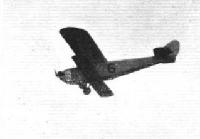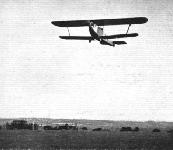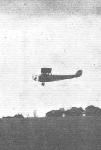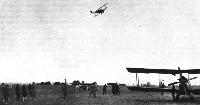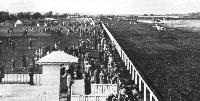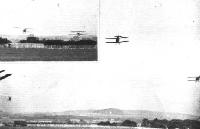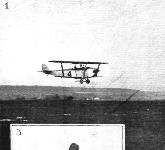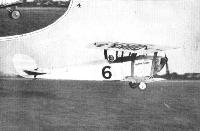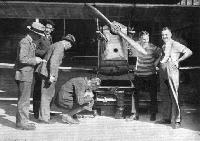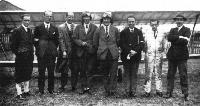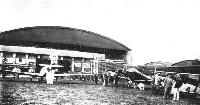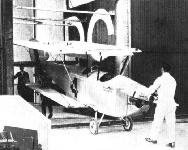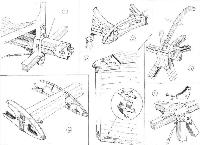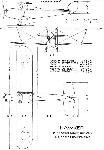
Hawker Cygnet
В ответ на объявленный Министерством авиации конкурс легких аэропланов, который должен был состояться в сентябре 1924 года в Лимпне, Кент, фирма "H.G. Hawker Engineering Company" разработала и построила два экземпляра легкого самолета под обозначением Hawker Cygnet. Самолет представлял собой биплан деревянной конструкции с полотняной обшивкой с зависающими элеронами вдоль всей задней кромки верхнего крыла, обычным оперением и шасси с хвостовым костылем. Один самолет (G-EBMB) был оснащен двигателем British Anzani мощностью 34 л. с. (25 кВт), а второй (G-EBJH) - ABC Scorpion такой же мощности. Призовые места на конкурсе 1924 года занять не удалось. Лишь в 1926 году, оснащенный мотором Bristol Cherub III, самолет G-EBMB выиграл приз газеты "Дейли Мейл" в 3000 фунтов, а самолет G-EBJH стал первым в открытых гонках с гандикапом.
ТАКТИКО-ТЕХНИЧЕСКИЕ ХАРАКТЕРИСТИКИ
Hawker Cygnet
Тип: двухместный легкий спортивный самолет
Силовая установка: один ПД Bristol Cherub III мощностью 34 л. с. (25 кВт)
Летные характеристики: максимальная скорость у земли 132 км/ч; потолок 2715 м
Масса: пустого 169 кг; максимальная взлетная 431 кг
Размеры: размах крыла 8,53 м; длина 6,22 м; высота 1,78 м; площадь крыльев 15,33 м2
Описание:
- Hawker Cygnet
- Flight, September 1924
THE SOPWITH-HAWKER LIGHT BIPLANES (Nos. 14 AND 15) - Flight, September 1926
British Light ‘Plane Development & Lympne Meeting
Фотографии
-
Aeroplane Monthly 1993-03 / M.Oakey - Grapevine
Регистрационный номер: G-CAMM [3] Don Cashmore’s latest replica, Hawker Cygnet G-CAMM, has taken him five years to build. Powered by a 35 h.p. Mosier flat twin, it was due to make test flights as soon as the weather was suitable.
-
Aeroplane Monthly 1993-09 / M.Oakey - Grapevine
Регистрационный номер: G-CAMM [3] Don Cashmore flew his recently-completed Hawker Cygnet replica G-CAMM to the Shuttleworth Sundown Flying Display at Old Warden on July 17, 1993.
-
Flight 1924-10 / Flight
Raynham, on the Hawker biplane, flying at Lympne.
-
Flight 1927-04 / Flight
GOOD HAND: Ragg on the Farnborough Hawker "Cygnet."
-
Flight 1926-09 / Flight
When Old Mother Swan wasn't looking. No. 6, the Hawker "Cygnet" doing a bit of "stunting."
-
Flight 1926-09 / Flight
THE START OF THE COMPETITION: Some of the competing machines on Sunday morning at the start for Brighton. 4, Bulman on the Hawker "Cygnet" is first man home in the first circuit. The best fuel consumption on this circuit was scored by Bulman.
-
Flight 1927-04 / Flight
RAGG OUT (TO WIN): A typical picture of the Farnborough Hawker "Cygnet." Often this machine would fly between the rails instead of above them.
-
Aeroplane Monthly 1985-10 / R.Riding - Hawker Cygnet /British pre-war ultralights/ (55)
Регистрационный номер: G-EBMB [12] The newly-restored Hawker Cygnet G-EBMB flying at the Royal Aeronautical Society's Garden Party at White Waltham in May 1950. Today the aircraft can be seen in the Sydney Camm Memorial Hall at the RAF Museum at Hendon.
-
Aeroplane Monthly 1985-10 / R.Riding - Hawker Cygnet /British pre-war ultralights/ (55)
LOW-SPEED FLYING AT LYMPNE: 2, Longton on No. 14 Hawker.
Sqn Ldr W. H. Longton flying Cygnet No 14 during the Lympne trials in October 1924. -
Flight 1926-09 / Flight
THE START OF THE COMPETITION: Some of the competing machines on Sunday morning at the start for Brighton. 3, Chick on the Farnborough Hawker "Cygnet" gets away well.
-
Aeroplane Monthly 1985-10 / R.Riding - Hawker Cygnet /British pre-war ultralights/ (55)
Регистрационный номер: G-EBMB [12] Cygnet G-EBMB, taking part in the 1926 Lympne meeting, by which time it had been reengined with the well-proven Bristol Cherub III.
-
Flight 1926-12 / Flight
Регистрационный номер: G-EBMB [12] The Hawker "Cygnet" is a two-seater "light" aeroplane in the actual sense, the structure weight being only 300 lbs. Fitted with Bristol Cherub engine, this machine won the "Daily Mail" Competition this year, and a sister machine obtained second place.
-
Flight 1925-08 / Flight
Регистрационный номер: G-EBMB [12] THE INTERNATIONAL HANDICAP: This event was won on the Hawker "Cygnet," which is seen doing a turn round the tent.
-
Flight 1926-09 / Flight
Регистрационный номер: G-EBMB [12] THE LYMPNE OPEN HANDICAP: 3. The Hawker "Cygnet" trying to beat its handicap
-
Flight 1925-08 / Flight
THE INTERNATIONAL HANDICAP: This event was won on the Hawker "Cygnet," which is seen crossing the finishing line
-
Flight 1926-09 / Flight
THE WINNING SMILE: Flight-Lieut. Bulman crossing the finishing line at Lympne as winner of first prize in the "Daily Mail" light 'plane competition.
-
Flight 1927-04 / Flight
FINISH OF WINTON HANDICAP: In the lead is Ragg on the Farnborough Hawker "Cygnet" flying low. He repeatedly flew between the white rails and the enclosures. Behind him is Comper on CLA4. In the original photograph four more machines can be seen in the background, approaching the finishing line.
Другие самолёты на фотографии: Comper Cranwell IV / CLA.4 - Великобритания - 1926
-
Flight 1926-09 / Flight
THE RACE FOR THE GROSVENOR CHALLENGE CUP: No less than 21 machines faced the starter for this race, a record number. The result was that machines frequently got bunched together at the turning points. Our photograph show one of some such incidents. In 1 are seen the D.H. 53, the Farnborough "Cygnet," and the Cranwell biplane approaching the aerodrome turning point.
Другие самолёты на фотографии: Comper Cranwell IV / CLA.4 - Великобритания - 1926De Havilland Humming Bird / D.H.53 - Великобритания - 1923
-
Flight 1926-09 / Flight
THE RACE FOR THE GROSVENOR CHALLENGE CUP: No less than 21 machines faced the starter for this race, a record number. The result was that machines frequently got bunched together at the turning points. Our photograph show one of some such incidents. 2, shows the wing tips of the Cranwell, the Hawker "Cygnet," the Blackburn "Bluebird," and one of the D.H. "Moths" heading for the Postling turning point.
Другие самолёты на фотографии: Blackburn Bluebird / L.1 - Великобритания - 1924Comper Cranwell IV / CLA.4 - Великобритания - 1926De Havilland Genet Moth - Великобритания - 1926
-
Flight 1926-09 / Flight
THE LYMPNE OPEN HANDICAP: 1. No. 4, the Farnborough "Cygnet," winning this event.
-
Flight 1924-10 / Flight
LOW-SPEED FLYING AT LYMPNE: 5, Raynham on the Hawker "Cygnet II."
-
Flight 1924-10 / Flight
TAKE-OFF AND PULL-UP TESTS AT LYMPNE: 4, Raynham making a landing on the Hawker "Cygnet II."
-
Мировая Авиация 97
Регистрационный номер: G-EBMB [12] Август 1924г.: фирма "Hawker" выставила на соревнования в Лимпне небольшой элегантный Cygnet, одну из ранних конструкций С. Кэмма.
На снимке первый Cygnet, оснащенный двигателем Bristol Cherub III. Казалось бы, выигравший конкурс легких аэропланов должен стать настоящим "народным самолетом", но фактически любимцем оказался de Havilland Moth, даже не принимавший участия в состязаниях! -
Flight 1927-04 / Flight
Регистрационный номер: G-EBMB [12] AT THE BOURNEMOUTH MEETING: 1, Bulman on the Hawker "Cygnet."
-
Flight 1926-09 / Flight
Регистрационный номер: G-EBMB [12] ELIMINATING TRIALS AT LYMPNE: 4, a "close-up" of Bulman landing the Hawker "Cygnet."
-
Flight 1926-09 / Flight
The shortest pull-up in 1924 was scored by Longton on the Hawker "Cygnet," with Anzani engine.
The Light 'Plane Competition, Lympne: Longton on No. 14, the Hawker biplane, "Cygnet," landing after the first circuit in the eliminating trials. -
Flight 1926-09 / Flight
THE WINNING SMILE: The Hawker "Cygnet" is seen coming to rest, while admirers run out to congratulate "George" on his success.
-
Air-Britain Archive 1985-03
Регистрационный номер: G-EBMB [12] The R.A.E. Aeroplane Club at Farnborough used some rather less common types including three DH Humming Birds (only one between 1927 and 1928) and Hawker Cygnet G-EBMB illustrated here.
-
Flight 1926-02 / Flight
THE HAWKER "CYGNET" LIGHT BIPLANE: The above machine has been presented by the Hawker Engineering Co., Ltd., to the R.A.E. Light Aero Club of Farnborough. It is now fitted with a Bristol "Cherub" engine instead of the A.B.C. "Scorpion" originally fitted (as shown).
-
Aeroplane Monthly 1985-10 / R.Riding - Hawker Cygnet /British pre-war ultralights/ (55)
Three views of Cygnet No 15, powered by an ABC Scorpion, photographed at Brooklands shortly after completion in August 1924. The other Cygnet, No 14, was powered by an Anzani engine. Both were plagued with engine trouble throughout the 1924 trials but managed to secure third and fourth places.
-
Flight 1925-07 / Flight
SOME LIGHT PLANES COMPETING AT LYMPNE: The Hawker "Cygnet" with British Anzani engine.
-
Flight 1924-10 / Flight
TAKE-OFF AND PULL-UP TESTS AT LYMPNE: 1, Wheeling Longton's Hawker "Cygnet I" and Douglas's Parnall "Pixie IIIa " back for the take-off tests.
Другие самолёты на фотографии: Parnall Pixie - Великобритания - 1923
-
Air Pictorial 1994-08 / Register Review
Регистрационный номер: G-CAMM [3] Registered in honour of its famous designer Sydney Camm, the immaculate Mosler engined Hawker Cygnet replica G-CAMM took part in the Shuttleworth Trust air display at Old Warden on 5/6/94
-
Flight 1926-09 / Flight
"Weighed but not found wanting": The Hawker "Cygnet" on the scales. On the right Mr. Fordham, of the Hawker Company.
-
Flight 1926-09 / Flight
THE WINNING SMILE: A group of "Hawkers" in front of the winning "Cygnet." Left to right : Mr. F. Sigrist, Mr. Hayward, Lieut. Bulman, Mr. Peaty, Mrs. Bulman and Mr. Jones.
-
Flight 1926-09 / Flight
THE FARNBOROUGH TEAM (Second in Competition): Left to right, E. Brame, S. O. Smith, Manning Harris, F.O. Ragg, Flight-Lieut. Chick, G. N. G. Peters, W. Baker, and the "Flying Marshal," Mr. Preston.
-
Aeroplane Monthly 1992-01 / J.Fozard - Camm's engine legacy
Регистрационный номер: G-EBMB [12] THE INTERNATIONAL HANDICAP: Contented "Hawkers!" Left to right, Mr. Sidney Camm, designer of the "Cygnet," Mr. Jones, of the Hawker Co., and Flight-Lieut. Bulman, pilot of the "Cygnet."
Hawker Cygnet G-EBMB in 1925 with, left to right, Sydney Camm, H. K. Jones, then commercial manager and overseas salesman, and P. W. S. “George” Bulman, chief pilot from 1925 to World War Two. -
Flight 1924-10 / Flight
AT THE LYMPNE LIGHT 'PLANE TRIALS: Lord Ed. Grosvenor (right) and Mr. W. H. Longton, discussing prospects.
-
Aviation Historian 5 / N.Stroud - The Last of the Many
Регистрационный номер: G-EBMB [12] A regular sight at 1950s British airshows was Hawker’s fleet of Sydney Camm-designed aircraft, which comprised, from nearest to furthest, Hart G-ABMR (currently on display at RAF Museum Hendon), Tomtit G-AFTA (still airworthy with the Shuttleworth Collection), Cygnet G-EBMB (now at RAF Museum Cosford) and G-AMAU.
Другие самолёты на фотографии: Hawker Hart - Великобритания - 1928Hawker Hurricane - Великобритания - 1935Hawker Tomtit - Великобритания - 1928
-
Flight 1926-09 / Flight
AT THE SALES: Competitors waiting at the petrol "shop" to be served. On the right, in front of the Farnborough Hawker "Cygnet" may be seen Air Vice-Marshal Sir Sefton Brancker with Capt. Goodman Crouch.
-
Flight 1926-09 / Flight
LINE UP FOR THE S.M.M.T. RACE: From left to right the machines are: de Havilland "Moth," Avro "Avian," Farnborough "Cygnet," Parnall "Pixie," and Bristol "Brownie." This race was won by Hinkler on the Avro "Avian," at an average speed of 90 m.p.h.
Другие самолёты на фотографии: Avro Avian / Type 594/616 - Великобритания - 1926Bristol Brownie / Type 91 - Великобритания - 1924De Havilland Genet Moth - Великобритания - 1926Parnall Pixie - Великобритания - 1923
-
Flight 1926-10 / Flight
Регистрационный номер: G-EBMB [12] IMPUDENCE AND DIGNITY AT THE CROYDON DEMONSTRATION: This photograph shows the Hawker "Cygnet" light 'plane taking off, with the Armstrong-Whitworth "Argosy" three-engined commercial aeroplane flying above it and a squadron of Vickers "Virginia" night bombers in the distance.
Другие самолёты на фотографии: Armstrong Whitworth Argosy - Великобритания - 1926Vickers Virginia - Великобритания - 1922
-
Flight 1926-09 / Flight
THE FIRST OF THE ELIMINATING TESTS AT LYMPNE: Some of the competing machines photographed during the folding, housing and re-erecting test. 2, the Farnborough Hawker "Cygnet."
-
Flight 1924-10 / Flight
SOME MORE CONSTRUCTIONAL DETAILS FROM LYMPNE: (3) Bottom plane attachment to wing roots on Sopwith-Hawker "Cygnets." The wing roots are covered with aluminium.
-
Flight 1924-09 / Flight
SOME CONSTRUCTIONAL DETAILS OF THE HAWKER LIGHT TWO-SEATER BIPLANE: 1 shows a typical fitting attaching the lower front spar to the lower longeron. In 2 is shown the manner in which the projecting spar roots are strengthened and streamlined. Note the hinge on the rear spar for folding the wing. The fuselage construction, using X-section longerons and struts connected by three-ply gussets, is shown in 3 while details of the wing construction are shown in 4. Examples of bent plate work in the region of the stern post are illustrated in 5, and 6 shows the flat plate fitting at the point of attachment of the centre-section struts to the fuselage longeron.
-
Flight 1924-09 / Flight
Hawker 2-seater Light Biplane A.B.C. "Scorpion" Engine
- Фотографии





